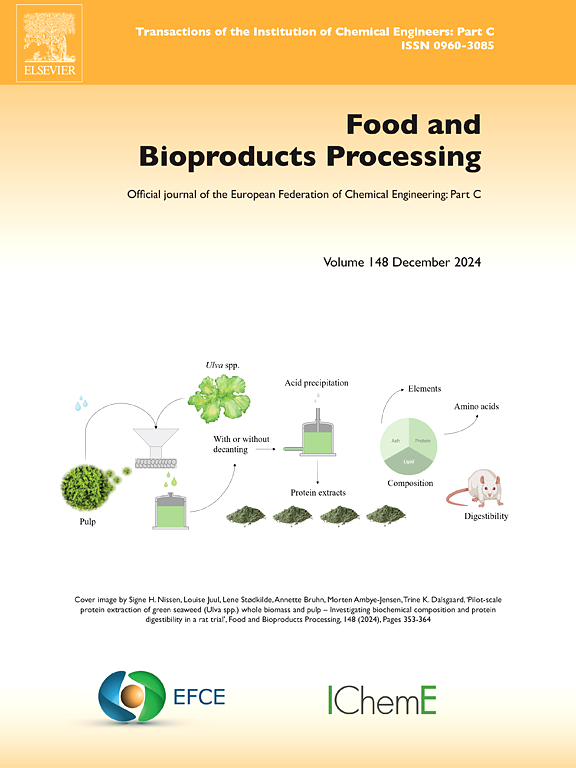Intelligent control of ginger far-infrared radiation and hot-air drying based on multi-sensor fusion technology
IF 3.5
2区 农林科学
Q2 BIOTECHNOLOGY & APPLIED MICROBIOLOGY
引用次数: 0
Abstract
In this study, a far infrared radiation and hot-air drying (FIR-HAD) system with multi-sensor detection was developed. Flavor and image information of ginger slices were online monitored with a PEN3 electronic nose and computer vision throughout the whole drying process, respectively. Firstly, ginger slices were dried at four constant temperatures. The response signals of the W1W and W2W sensors (the two most responsive sensors in PEN3 electronic nose system), as well as ΔE (color difference), BI/BI0 (browning index of dried samples/ browning index of fresh samples), were determined to reflect flavor and color changes based on results from the multi-sensor results. The effects of various constant drying temperatures on the main chemical properties of ginger slices were also examined. The results indicate that the dried samples subjected to FIR-HAD at 60 °C had the highest content of 6-gingerol and 8-gingerol compared to other constant drying temperature. In addition, the antioxidant activity and total flavonoid content were also maintained at satisfactory levels under this condition. Then, a fuzzy logic control (FLC) strategy was developed to continuously adjust the output power for optimizing the FIR-HAD process. To determine fuzzy input parameters, the correlation analysis between the online detection signals and the main chemical properties was conducted based on the moisture ratio of samples. The FLC strategy was developed in two stages based on the results of the correlation analysis, with various control rules applied at each stage. The organoleptic quality and chemical quality of dried samples using FLC drying were significantly improved compared to the constant temperature drying. In addition, the FLC drying strategy achieved the highest gray relational degree value, a metric used to evaluate the overall performance of various drying strategies based on multiple indicators, in the assessment of drying time, color properties, and main qualities. This indicates that combining the FLC strategy with multi-sensor detection technology provides an advantageous optimal treatment for FIR-HAD.
基于多传感器融合技术的生姜远红外辐射与热风干燥智能控制
本研究开发了一种多传感器检测的远红外辐射热风干燥系统。利用PEN3电子鼻和计算机视觉在线监测生姜片在整个干燥过程中的风味和图像信息。首先,生姜片在四种恒温条件下干燥。根据PEN3电子鼻系统中响应最灵敏的两个传感器W1W和W2W的响应信号,以及ΔE(色差)、BI/BI0(干燥样品褐变指数/新鲜样品褐变指数)的响应信号,根据多传感器的结果确定反映风味和颜色变化。考察了不同恒定干燥温度对姜片主要化学性质的影响。结果表明,与其他恒定干燥温度相比,在60℃条件下经FIR-HAD处理的干燥样品中6-姜辣素和8-姜辣素的含量最高。此外,在此条件下,其抗氧化活性和总黄酮含量也保持在满意的水平。然后,提出了一种模糊逻辑控制(FLC)策略来连续调节输出功率,以优化FIR-HAD过程。为确定模糊输入参数,基于样品含水率对在线检测信号与主要化学性质进行相关性分析。基于相关分析的结果,FLC策略分为两个阶段,每个阶段应用不同的控制规则。与恒温干燥相比,FLC干燥干燥后样品的感官品质和化学品质均有显著提高。此外,FLC干燥策略在干燥时间、颜色特性和主要品质的评估中获得了最高的灰色关联度值,灰色关联度值是基于多个指标评估各种干燥策略整体性能的指标。这表明FLC策略与多传感器检测技术相结合为FIR-HAD提供了一种有利的优化治疗方法。
本文章由计算机程序翻译,如有差异,请以英文原文为准。
求助全文
约1分钟内获得全文
求助全文
来源期刊

Food and Bioproducts Processing
工程技术-工程:化工
CiteScore
9.70
自引率
4.30%
发文量
115
审稿时长
24 days
期刊介绍:
Official Journal of the European Federation of Chemical Engineering:
Part C
FBP aims to be the principal international journal for publication of high quality, original papers in the branches of engineering and science dedicated to the safe processing of biological products. It is the only journal to exploit the synergy between biotechnology, bioprocessing and food engineering.
Papers showing how research results can be used in engineering design, and accounts of experimental or theoretical research work bringing new perspectives to established principles, highlighting unsolved problems or indicating directions for future research, are particularly welcome. Contributions that deal with new developments in equipment or processes and that can be given quantitative expression are encouraged. The journal is especially interested in papers that extend the boundaries of food and bioproducts processing.
The journal has a strong emphasis on the interface between engineering and food or bioproducts. Papers that are not likely to be published are those:
• Primarily concerned with food formulation
• That use experimental design techniques to obtain response surfaces but gain little insight from them
• That are empirical and ignore established mechanistic models, e.g., empirical drying curves
• That are primarily concerned about sensory evaluation and colour
• Concern the extraction, encapsulation and/or antioxidant activity of a specific biological material without providing insight that could be applied to a similar but different material,
• Containing only chemical analyses of biological materials.
 求助内容:
求助内容: 应助结果提醒方式:
应助结果提醒方式:


